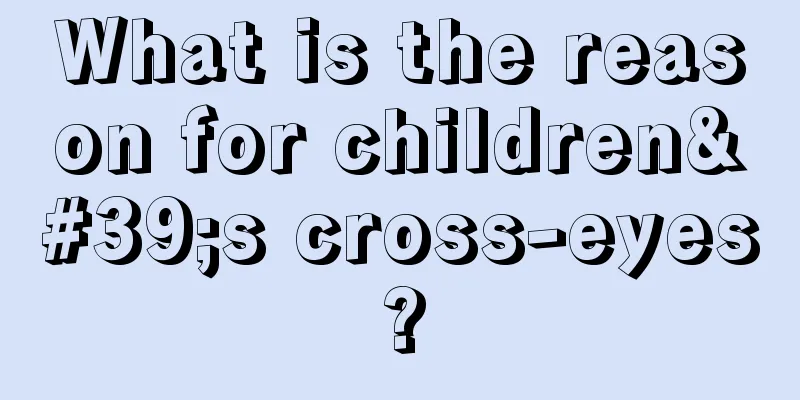What is the reason for children's cross-eyes?

|
Cross-eye is an eye disease that often occurs in children. To put it simply, cross-eye is a form of strabismus. Some people say that cross-eyes cannot be cured. This makes sense when medical technology is underdeveloped. However, with modern medical technology, cross-eyes can be cured. But for patients, the only problem is that the disease cannot be cured. So, what are the reasons why children cross their eyes? Cross-eyes refers to the situation where the pupils in the middle of the eyes are naturally or artificially moved closer to the center, making them look like two chickens fighting. Hence the name cross-eyes, also known as crossed eyes. When a normal person looks at the same object with both eyes, images of the object are formed on the retinas of both eyes and overlap in the visual center of the brain to become a complete, three-dimensional single object. This function is called binocular single vision. However, infants and young children are easily affected by external factors during the process of developing binocular single vision, causing one eye to focus on a target while the other eye deviates and cannot look at the same target, thus resulting in strabismus. In medicine, the condition of the eyes looking inward when looking at an object is called esotropia, which is commonly known as "cross-eyed". Cause (1) Imperfect development: Children, especially infants and young children, have incomplete binocular vision function and cannot coordinate the extraocular muscles well. Any unstable factors can cause strabismus. Human's monocular vision function is gradually developed after birth. Just like the visual function, this function is established by repeatedly receiving stimulation from clear external images, and gradually develops and matures. Infants only have gross fusion image 2 months after birth, and the establishment of precise fusion image function will continue until after 5 years old. Stereoscopic vision is established at the latest, and it is close to that of adults at 6 to 7 years old. Therefore, the period before the age of 5 when binocular single vision function is not yet perfect is a high incidence period of strabismus in children. (2) Congenital abnormalities: This type of strabismus is mostly caused by congenital abnormalities in the position and development of the extraocular muscles, abnormal development of the extraocular muscles themselves, incomplete differentiation of the mesoderm, poor separation of the eye muscles, abnormal muscle sheaths and fibrosis, and other anatomical defects or paralysis of the nerves that control the muscles. Some cases are due to the use of forceps during delivery, which causes damage to the baby's head and face, or the mother's excessive force during delivery, which causes increased intracranial pressure on the fetus and produces punctate hemorrhages in the brain. The bleeding happens to be in the nerve nucleus that controls eye movement, causing paralysis of the extraocular muscles. In addition, there are also genetic factors. Strabismus is not inherited by all members of the family. This defect is often indirectly passed on to the next generation of children. Generally, strabismus that occurs within 6 months after birth is called congenital strabismus. It does not have the basic conditions for establishing binocular vision and has the greatest harm to the development of visual function. (3) The characteristics of eye development make children susceptible to strabismus: because children’s eyeballs are small and their eye axes are short, they are mostly farsighted. Also, because children’s corneas and lenses have strong refractive power and their ciliary muscles have strong contraction power, they have strong accommodation power. Such children need more accommodation power to see objects clearly. At the same time, their eyes turn inward forcefully, resulting in excessive convergence, which can easily cause esotropia, a type of esotropia called accommodative esotropia. (4) Insufficient control of the eye movement center: If convergence is too strong or abduction is insufficient, or both exist at the same time, esotropia will occur; conversely, if abduction is too strong, convergence is insufficient, or both exist at the same time, exotropia will occur. |
<<: What medicine is good for children with tonsil suppuration?
>>: Which department should I go to for breast development in children?
Recommend
What is the best food for children with colds?
Children's immune system cannot be compared w...
What are the preventive measures for infectious diseases in spring for young children?
With the arrival of spring, various infectious di...
How to treat a one-year-old baby's cold
Colds are caused by mutated viruses and are chara...
What causes children’s gums to become red, swollen and bleeding?
Children’s teeth are always fragile. Sometimes, f...
What to do if your child keeps coughing?
What to do if a child keeps coughing? Every paren...
What happens if my child has lymph nodes behind his neck?
Children are the cutest angels in the world and t...
Why does the baby always hum when sleeping?
Babies' bodies are relatively weak, and they ...
Be careful! These 8 bad habits make children stupider and stupider
Bad habit 1: Long-term fullness Modern nutritiona...
Why does my child always pick his hands?
Some babies always make some habitual hand-pickin...
How to deal with children's abrasions
Children are lively and active, and seem to have ...
What to do if infants and young children are constipated
Constipation is caused by indigestion and the ina...
Baby's eyes have red bloodshot
Newborns often bleed after the umbilical cord fal...
The child urinates a little
Since children do not have the ability to urinate...
5 nutritious breakfasts for kids
A year's plan starts with spring; a day's...
What to do if your child refuses to use eye drops
I believe many people know about eye drops. This ...









